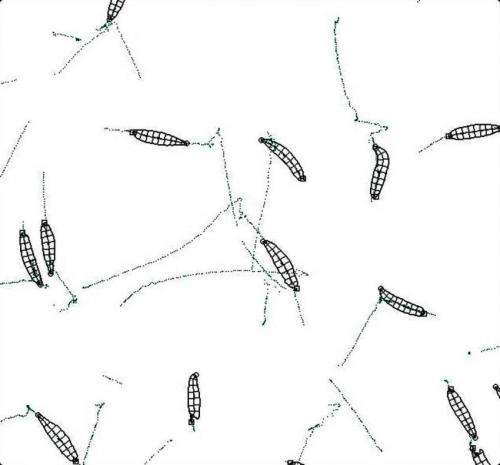The Multi-Worm Tracker software tracked time-varying contours of larvae. The time-varying contours carry information about how larvae behaved when specific neurons were activated by optogenetics. Credit: Vogelstein, Park, Ohyama et al.
(Medical Xpress)—A team of researchers from Johns Hopkins University and Janelia Farm Research Campus has developed a new technique for studying neural circuits that helps tie circuit activity to organism behavior. In their paper published in the journal Science, the team describes how they used light activated proteins in neurons in conjunction with statistical analysis to create a reference atlas that describes 29 individual fruit fly larvae phenotypes.
Figuring out what the brain is doing when an organism is performing tasks has proved to be very difficult. To help the process along, researchers study relatively simple organisms with far fewer neurons than higher level animals—they also tend to have relatively simple neural circuitry. Still, progress has been slow, to say the least. In this new effort, the researchers report that they have, for the first time, been able to create a table, or reference atlas, for the fruit fly larvae that links certain neural circuit activities with certain behaviors, such as backing up.
To figure out what the brain is doing when an organism is doing something, researchers have studied the brains of individual specimens (using fMRI, for example) as they go about their business. This approach has so far proven to be not only tedious, but results in data that applies to just a single organism. In this new effort, the researchers took a much different approach—they manipulated neurons to respond to light (using optogenetics) in the brains of 37,780 individual larva then trained cameras on them as they went about their business to record their movements. The recordings produced massive amounts of data that could only be crunched by a computer, which is why the team used statistical analysis to coax out patterns of behavior that could be linked to certain activities. In so doing, they wound up creating behavioral trees to describe the subtle differences between different movements. This allowed them to create an atlas that described 29 distinguishable activities that could be tied to certain neural circuitry activations.
Behaviotype 1: Larva makes one small left head turn (appears right in this video) followed by a large right head turn (appears left in this video) and then initiates crawling, interrupted once more by a couple of short head turns; crawling gets faster and faster. For more information, see Video S1 in the Supplementary Video Captions section of the Supporting Online Material. Credit: Vogelstein et al., Science/AAAS
Behaviotype 6: Larva makes one small right head turn (appears left in this video) followed by a large left head turn (appears right in this video) and then initiates crawling. Crawling is interrupted by few short head turns. For more information, see Video S12 in the Supplementary Video Captions section of the Supporting Online Material. Credit: Vogelstein et al., Science/AAAS
The creation of the atlas represents a significant step forward in mapping neural circuitry in an organism and paves the way for similar work on organisms with more sophisticated neural networks. The researchers plan to next extend their research to adult fruit flies, and eventually, to mice.
More information: Discovery of Brainwide Neural-Behavioral Maps via Multiscale Unsupervised Structure Learning, Science DOI: 10.1126/science.1250298
ABSTRACT
A single nervous system can generate many distinct motor patterns. Identifying which neurons and circuits control which behaviors has been a laborious piecemeal process, usually for one observer-defined behavior at a time. We present a fundamentally different approach to neuron-behavior mapping. We optogenetically activated 1,054 identified neuron lines in Drosophila larva and tracked the behavioral responses from 37,780 animals. Applying multiscale unsupervised structure learning methods to the behavioral data identified 29 discrete statistically distinguishable and observer-unbiased behavioral phenotypes. Mapping the neural lines to the behavior(s) they evoke provides a behavioral reference atlas for neuron subsets covering a large fraction of larval neurons. This atlas is a starting point for connectivity- and activity-mapping studies to further investigate the mechanisms by which neurons mediate diverse behaviors.
Journal information: Science
© 2014 Medical Xpress






















